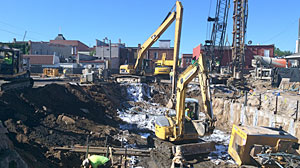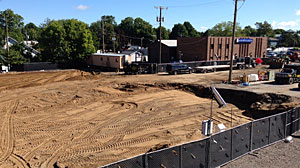Times change, and knowledge grows. We know now that the way we manufactured gas historically had some unintended consequences for the environment. MGU restores these areas so they can be used by today's communities.

Cleanup at the former MGU Coldwater manufactured gas plant site in 2014
The history of manufactured gas plants
From the early 1800s until the 1960s, local plants manufactured gas for heating and lighting. These plants were the pride of many cities, because gas was a better source of energy. Gas lights replaced oil lamps, and gas eliminated the need to cook and heat with wood or coal. The plants prospered until more affordable, cleaner natural gas began to arrive by pipeline. There are about 2,000 to 2,500 gas plant sites in the U.S.
Environmental issues with manufactured gas plants
The process of manufacturing gas resulted in byproducts. This included tars, oils and wood chips. Many plants sold the byproducts, especially the coal tar, which could be distilled and used in dozens of products, including fuels, fertilizer, creosote, plastics and pharmaceuticals.
Byproducts that could not be sold were sometimes left on-site. At most plants, storage tanks were made of wood or brick, with piping and other equipment that may have leaked. When the plants were demolished, some waste may have been left on-site. At the time, there were no regulations for disposing of such materials, and these practices were common. However, the result is that some byproducts are still present in the soil and river sediments today. At the depths where they typically occur, they don't present a hazard to people on or near the site. But they do need to be cleaned up to protect groundwater beneath the site.
The chemicals in soil and groundwater at the sites fall into three main categories:
- Volatile organic compounds, like those found in gasoline.
- Polynuclear aromatic hydrocarbons, which are present in byproducts of incomplete combustion (such as car exhaust), asphalt roads, roofing tars, grilled food and other common materials.
- Inorganic compounds such as metals, which came from the coal and gas purifying process.
Former MGU manufactured gas plant cleanup — Coldwater

Site restoration activities following cleanup
MGU operated a plant in Coldwater from the 1860's through the 1920's. When the plant was closed residual by-products remained in the soil. The site is currently a city-owned parking lot located in downtown Coldwater.
Following several years of site investigation activities, discussions with the Michigan Department of Environmental Quality (MDEQ), City of Coldwater and adjacent property owners, MGU initiated a cleanup of the site 2014. Over 23,000 tons of contaminated soil and debris were excavated during cleanup. Since the excavation extended deep (25 feet below ground surface) groundwater was encountered and had to be handled during the project. Approximately 350,000 gallons of groundwater was treated and discharged to the City's sanitary system.
Upon completion of cleanup activities the City of Coldwater upgraded the utilities in this area and reconstructed the parking lot to current standards. MGU has worked closely with the MDEQ and the City of Coldwater throughout this project.